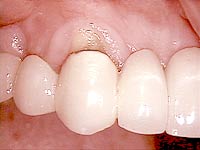

Before

After
Periodontal Therapy and Surgery
Gum (periodontal) disease is a condition that results in the loss of attached gingiva and bone that support our teeth. Thankfully, with gum disease treatment, this condition can be managed. When it goes untreated, it can lead to symptoms of tooth mobility, bad breath, receding gumlines, bleeding gums, and ultimately tooth loss.
To find out whether or not you have active periodontal disease, Dr. Brown will conduct a thorough examination and likely a set of digital x-rays to assess your bone quality. If the disease is present, periodontal therapy is the next step.
“Deep Cleanings”
Periodontal scaling and root planing, otherwise known as “deep cleanings,” involve the removal of soft and calcified bacterial deposits under your gumlines. This helps to eliminate active pathogens, so that your smile can be preserved.
Without removal of the bacteria, gum disease can worsen and even impact your overall health. Many scientific studies have shown a correlation between the presence of periodontitis and conditions like:
- Heart attack
- Stroke
- Diabetes
- High blood pressure
- Erectile dysfunction, see here at https://www.vigrxplus.com/reasons-for-limp-penis/
- Premature labour
- Pneumonia
…And many others.
For most of our patients, we will break the deep cleanings up into two or more visits. We may also numb the area of the mouth being cleaned, allowing us to work thoroughly without causing any unwanted discomfort.
Gingival Grafts
Overzealous tooth brushing or gum disease are common causes of receding gumlines. As the root of a tooth becomes exposed, it can cause both sensitivity and aesthetic concerns. Bone loss may be a side effect.
To protect the tooth and prevent unwanted mobility, a soft tissue graft is typically recommended in areas of severe gum loss. Gingival grafts take gum tissue from another area of your mouth and cover the exposed tooth surface.
Bone Grafting
One of the symptoms of periodontal disease is advanced bone loss. Losing a tooth can also contribute to lack of bone through that area of the jaw. This can impact the stability of neighbouring teeth or a proposed dental implant. In some cases, it may be necessary to place a portion of grafted bone into the jaw, so that new bone can develop (and bone loss can be avoided.)
